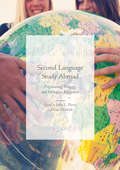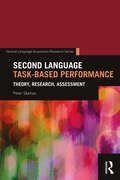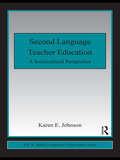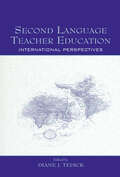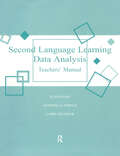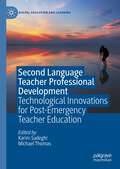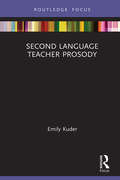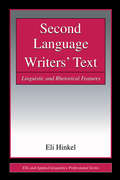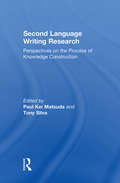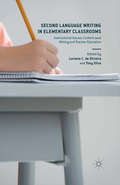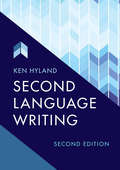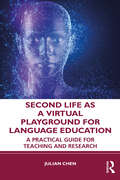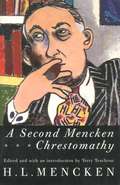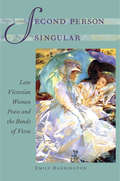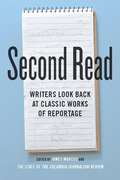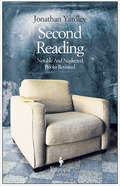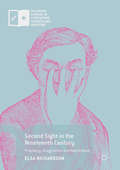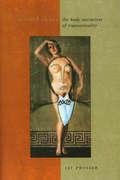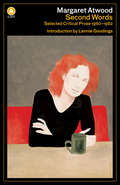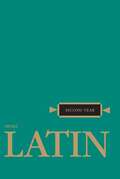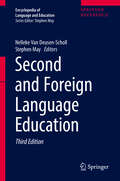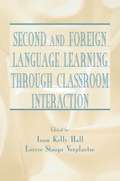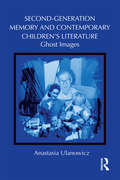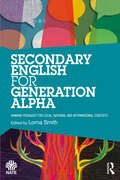- Table View
- List View
Second Language Study Abroad: Programming, Pedagogy, And Participant Engagement
by John L. Plews Kim MisfeldtThis edited volume explores studying second languages abroad by critically and constructively reviewing established programming, providing theoretical and research-informed support for pedagogical and curriculum interventions, and analysing participant experiences. Over 12 chapters the contributors examine key issues including teaching approaches, learning activities, and relationships in the target language and culture. This book is most distinct in its attempt to promote diversity in approaches and experiences while drawing the common thread of learner- and learning-centredness through each chapter. The contributing authors represent a wide range of academies and discuss study abroad programs and participants in diverse cultural and geographic regions. The book’s international scope will acquaint educators and researchers with a broad variety of practices, stimulate comparison across contexts, and promote innovation.
Second Language Task-Based Performance: Theory, Research, Assessment (Second Language Acquisition Research Series)
by Peter SkehanSecond Language Task-Based Performance is the first book to synthesize Peter Skehan’s theoretical and empirical contributions all in one place. With three distinct themes explored in each section (theory, empirical studies, and assessment), Skehan’s influential body of work is organized in such a way that it provides an updated reflection on the material and makes it relevant to today’s researchers. Also in each section, an early publication is matched by at least one later publication, followed by a newly written commentary chapter, the combination of which provides the important function of offering a wider-ranging discussion. This book is an invaluable resource for researchers interested in second language task-based research or SLA more generally.
Second Language Teacher Education: A Sociocultural Perspective (ESL & Applied Linguistics Professional Series)
by Karen JohnsonThis book presents a comprehensive overview of the epistemological underpinnings of a sociocultural perspective on human learning and addresses in detail what this perspective has to offer the field of second language teacher education. Captured through five changing points of view, it argues that a sociocultural perspective on human learning changes the way we think about how teachers learn to teach, how teachers think about language, how teachers teach second languages, the broader social, cultural, and historical macro-structures that are ever present and ever changing in the second language teaching profession, and what constitutes second language teacher professional development. Overall, it clearly and accessibly makes the case that a sociocultural perspective on human learning reorients how the field understands and supports the professional development of second language teachers.
Second Language Teacher Education: International Perspectives
by Diane J. TedickThe education of second language teachers takes place across diverse contexts, levels, settings, and geographic regions. By bringing together research, theory, and best practices from a variety of contexts (ESL/EFL, foreign language, bilingual and immersion education), this book contributes to building meaningful professional dialogue among second-language teacher educators. Featuring an international roster of authors, the volume is comprised of 18 chapters organized in four thematic sections: the knowledge base of second language teacher education; second language teacher education contexts; collaborations in second language teacher education; and second language teacher education in practice. Second Language Teacher Education: International Perspectives is an essential professional resource for practicing and prospective second language teacher educators around the world.
Second Language Teacher Manual 2nd: Second Edition
by Susan M. Gass Larry Selinker Antonella SoraceFirst Published in 1998. Routledge is an imprint of Taylor & Francis, an informa company.
Second Language Teacher Professional Development: Technological Innovations for Post-Emergency Teacher Education (Digital Education and Learning)
by Michael Thomas Karim SadeghiThis edited book brings together documented evidence and theoretical propositions on the essential mediating role of digital technology in L2 teacher education and professional development. Topics range from technological affordances in teacher education, to challenges and responses to emergency transition from face to face to virtual professional development, to successful practices of online teacher training courses. Bringing together examples from various countries and contexts of how L2 teacher trainers and trainee teachers view these forced changes and react to them, the volume fills a gap in the use of digital technology in contexts where teacher educators and trainee teachers are not technology-literate and not prepared for technology-oriented education. In addition to a Foreword by Mark Warschauer and Introduction and Conclusion chapters by Editors, the volume features 13 full-length chapters by some of the well-known experts from countries such as Australia, Finland, Mexico, the UK, the USA, Spain, Singapore, Turkey and Sweden.
Second Language Teacher Prosody
by Emily KuderSecond Language Teacher Prosody focuses on the prosodic characteristics of input in L2 Spanish classrooms. Readers are led through descriptions and interpretations of prosodic behaviors based upon teachers’ training and experience, their native or near-native speaker status, and their own comments about their teaching. The analysis culminates with several key discoveries and methodological implications with regard to didactic prosody, research design and methodology, and data interpretation. The conclusion offers future lines of research on SDS prosody including reception studies exploring the relative salience and effectiveness of prosodic cues. Educators can intentionally utilize these tools to achieve pedagogical goals. This book will be of interest to scholars in Applied Linguistics and Instructed Second Language Acquisition.
Second Language Writers' Text: Linguistic and Rhetorical Features (ESL & Applied Linguistics Professional Series)
by Eli HinkelThis comprehensive and detailed analysis of second language writers' text identifies explicitly and quantifiably where their text differs from that of native speakers of English. The book is based on the results of a large-scale study of university-level native-speaker and non-native-speaker essays written in response to six prompts. Specifically, the research investigates the frequencies of uses of 68 linguistic (syntactic and lexical) and rhetorical features in essays written by advanced non-native speakers compared with those in the essays of native speakers enrolled in first-year composition courses. The selection of features for inclusion in this analysis is based on their textual functions and meanings, as identified in earlier research on English language grammar and lexis. Such analysis is valuable because it can inform the teaching of grammar and lexis, as well as discourse, and serve as a basis for second language curriculum and course design; and provide valuable insight for second language pedagogical applications of the study's findings.
Second Language Writing Research: Perspectives on the Process of Knowledge Construction
by Paul Kei Matsuda Tony SilvaIn this original volume, eighteen researchers from different parts of the world reflect on their own research projects, providing insights into key methodological issues in research on second language writing. By offering a glimpse into the process of constructing and negotiating knowledge in the field--the messy space of situated practices of inquiry--it helps to demystify the research process, which can appear in published studies and in introductory methodology guides to be neater and more orderly than it actually is.Taking a broad conception of research as inquiry that emphasizes the situated and constructed nature of knowledge in the field, Second Language Writing Research: Perspectives on the Process of Knowledge Construction encourages multiple forms of inquiry, including philosophical, narrative, and historical modes. Empirical inquiry as presented in this book encompasses both quantitative and qualitative approaches as well as those that strategically combine them. A helpful discussion of the "nuts and bolts" of developing sustainable research programs is also provided. The volume as a whole facilitates a situated, issue-driven research practice. Its unique focus on second language writing research makes it an invaluable resource for both novice and experienced researchers in the field.
Second Language Writing in Elementary Classrooms: Instructional Issues, Content-area Writing and Teacher Education
by Luciana C. de Oliveira Tony SilvaSecond Language Writing in Elementary Classrooms.
Second Language Writing in Elementary Classrooms: Instructional Issues, Content-area Writing and Teacher Education
by Luciana C. de OliveiraSecond Language Writing in Elementary Classrooms focuses on L2 writing in elementary classrooms. It features chapters that highlight research in elementary classrooms focused on the writing development of multilingual children, and research in teacher education to prepare elementary teachers to teach L2 writing and address L2 writers' needs.
Second Language Writing: Contexts And Issues (The\michigan Series On Teaching Multilingual Writers)
by Ken HylandAuthoritative and accessible, this book introduces the theory and practice of teaching writing to students of EFL/ESL learners. While assuming no specialist knowledge, Ken Hyland systematically sets out the key issues of course design, lesson planning, texts and materials, tasks, feedback and assessment and how current research can inform classroom practice. This second edition is completely revised to include up-to-date work on automated feedback, plagiarism, social media, Virtual Learning Environments and teacher workload issues. It takes the clear stance that student writers not only need realistic strategies for drafting and revising, but also a clear understanding of genre to structure their writing experiences according to the expectations of particular communities of readers and the constraints of particular contexts. Review exercises, reflection questions, plentiful examples and a new extensive glossary make the book invaluable to both prospective and practicing teachers alike.
Second Life as a Virtual Playground for Language Education: A Practical Guide for Teaching and Research
by Julian ChenThis insightful book offers language teachers and teachers in training the opportunity to delve into 3D virtual worlds and see the benefits they provide for effective language teaching. Based on a decade of experience teaching and researching in Second Life (SL), Chen demystifies the dos and don’ts of SL teaching and research, whilst vividly walking readers through each step of the journey. Written in an accessible, jargon-free, and personalised tone, the book is divided into three parts. Part I builds the foundation in SL research, task-based language teaching (TBLT), and understanding fundamental skills for SL teaching. Part II showcases the author’s SL teaching blog that generously unveils their task-based, SL-enabled lessons, participant observations, critical reflections, and lessons learned from each SL session. Part III is complete with the highlights of the author’s SL research and hands-on resources and tips for readers. Each chapter also features a "Checkpoint" section to gauge reader understanding of chapter content, followed by a "Your Task" section to promote learning by doing in SL. Teachers and curriculum designers will find the well-detailed and guided lesson planning useful when starting their first SL class. Graduate students and novice researchers will also find the systematically recorded data collection helpful for their SL research.
Second Mencken Chrestomathy
by H. L. Mencken"This Wonderful Sequel to the best-selling A Mencken Chrestomathy of nearly half a century ago is full of the iconoclastic common sense that marked H. L. Mencken's astonishing career as the premier American social critic of the twentieth century. Gathered by Mencken himself before he died in 1956, this second chrestomathy ("a collection of selected literary passages," with the accent on the tom) contains writings about a variety of subjects - politics, war, music, literature, men and women, lawyers, brethren of the cloth. Some of his essays have beguiling titles - "Notes for an Honest Autobiography," "The Commonwealth of Morons," "Le Vice Anglais," "Acres of Babble," "Hooch for the Artist. " All of them are a pleasure to read, and we are reminded that what Mencken wrote in the early years of this century remains applicable to a very different America. "--BOOK JACKET. Title Summary field provided by Blackwell North America, Inc. All Rights Reserved
Second Person Singular: Late Victorian Women Poets and the Bonds of Verse (Victorian Literature and Culture Series)
by Emily HarringtonEmily Harrington offers a new history of women's poetry at the turn of the century that breaks from conventional ideas of nineteenth-century lyric, which focus on individual subjectivity. She argues that women poets conceived of lyric as an intersubjective genre, one that seeks to establish relations between subjects rather than to constitute a subject in isolation. Moving away from canonical texts that contribute to the commonly held notion that lyric poetry is an utterance made in solitude, Harrington explores the work of Christina Rossetti, Augusta Webster, A. Mary F. Robinson, Alice Meynell, and Dollie Radford to show how nineteenth-century poetic conventions shaped and were shaped by concepts of intimacy. Writing about relationships that are familial, divine, sexual, literary, and musical, these poets reconsidered the dynamics of absence and presence, and subject and object, that are at the heart of the lyric enterprise.Harrington locates these poets' theories of intimacy not only in their formal poetic practice but also in diverse prose works such as prefaces, literary and devotional essays, and unpublished letters and diaries. By analyzing various patterns of versification and modes of address, she articulates new ways of thinking about the bonds of verse and enlarges our understanding of verse culture in the late nineteenth century.
Second Read: Writers Look Back at Classic Works of Reportage (Columbia Journalism Review Books)
by James MarcusThe Columbia Journalism Review's Second Read series features distinguished journalists revisiting key works of reportage. Launched in 2004 by John Palattella, who was then editor of the magazine's book section, the series also allows authors address such ongoing concerns as the conflict between narrative flair and accurate reporting, the legacy of New Journalism, the need for reporters to question their political assumptions, the limitations of participatory journalism, and the temptation to substitute "truthiness" for hard, challenging fact. Representing a wide range of views, Second Read embodies the diversity and dynamism of contemporary nonfiction while offering fresh perspectives on works by Norman Mailer, Tom Wolfe, Rachel Carson, and Gabriel García Márquez, among others. It also highlights pivotal moments and movements in journalism as well as the innovations of award-winning writers.Essays include Rick Perlstein on Paul Cowan's The Tribes of America; Nicholson Baker on Daniel Defoe's A Journal of the Plague Year; Dale Maharidge on James Agee's Let Us Now Praise Famous Men; Marla Cone on Rachel Carson's Silent Spring; Ben Yagoda on Walter Bernstein's Keep Your Head Down; Ted Conover on Stanley Booth's The True Adventures of the Rolling Stones; Jack Shafer on Tom Wolfe's The Electric Kool-Aid Acid Test; Connie Schultz on Michael Herr's Dispatches; Michael Shapiro on Cornelius Ryan's The Longest Day; Douglas McCollam on John McPhee's Annals of the Former World; Tom Piazza on Norman Mailer's Armies of the Night; Thomas Mallon on William Manchester's The Death of a President; Miles Corwin on Gabriel García Márquez's The Story of a Shipwrecked Sailor; David Ulin on Joan Didion's Slouching Toward Bethlehem; and Claire Dederer on Betty MacDonald's Anybody Can Do Anything.
Second Reading: Notable And Neglected Books Revisited
by Jonathan YardleyThis collection of 5 dozen pieces of literary criticism was published in the Washington Post between March 2003 and January 2010. It is a collection of Yardley's opinions of books that he believes are worthy of a second look. They scan the realms of fiction, biography and autobiography, memoirs, and history.
Second Sight in the Nineteenth Century: Prophecy, Imagination and Nationhood (Palgrave Studies in Literature, Science and Medicine)
by Elsa RichardsonThis book explores the phenomenon of second sight in nineteenth-century literature and culture. Second sight is a form of prophetic vision associated with the folklore of the Scottish Highlands and Islands. Described in Gaelic as the An-da-shealladh or 'the two sights', those in possession of this extraordinary power are said to foresee future events like the death of neighbour, the arrival of strangers into the community, the success or failure of a fishing trip. From the late seventeenth century onwards, rumours of this strange faculty attracted the attention of numerous scientists, travel writers, antiquarians, poets and artists. Focusing on the nineteenth century, this book examines second sight in relation to mesmerism and phrenology, modern spiritualism and anthropology, romance literature and folklorism and finally, psychical research and Celtic mysticism. Tracing the migration of a supposedly 'Scottish' tradition through various sites of nineteenth-century popular culture, it explores questions of nationhood and identity alongside those posed by supernatural phenomena.
Second Skins: The Body Narratives of Transsexuality (Gender and Culture Series)
by Jay ProsserDo we need bodies for sex? Is gender in the head or in the body? In Second Skins Jay Prosser reveals the powerful drive that leads men and women literally to shed their skins and--in flesh and head--to cross the boundary of sex. Telling their story is not merely an act that comes after the fact, it's a force of its own that makes it impossible to forget that stories of identity inhabit autobiographical bodies.In this stunning first extensive study of transsexual autobiography, Jay Prosser examines the exchanges between body and narrative that constitute the phenomenon of transsexuality. Showing how transsexuality's somatic transitions are spurred and enabled by the formal transitions of narrative, Prosser uncovers a narrative tradition for transsexual bodies. Sex change is a plot--and thus appropriately transsexuals make for adept and absorbing authors. In reading the transssexual plot through transsexuals' own recounting, Prosser not only gives us a new and more accurate rendition of transsexuality. His book suggests transsexuality, with its extraordinary conjunctions of body and narrative, as an identity story that transitions across the body/language divide that currently stalls poststucturalist thought.The form and approach of Second Skins works to cross other important and parallel divides. In addition toanalyzing transsexual textual accounts, the book includes some 30 photographic portraits of transsexuals--poignant attempts by transsexuals to present themselves unmediated to the world except by the camera. And the author does not shy from exposure himself. Interjecting the personal into his theoretical discussion and close textual work throughout the book, Prosser reads and writes his own body, his purpose in that stylistic crossing to stake out transsexuality--and hence this very book--as his own body's narrative.
Second Words: Selected Critical Prose 1960–1982 (A List)
by Margaret AtwoodReissued in a handsome A List edition, the largest collection of critical prose to date from world renowned author and poet Margaret Atwood, featuring an introduction by Lennie Goodings.Originally published in 1982, Second Words brings together fifty of Margaret Atwood’s finest essays and reviews spanning two decades, beginning in 1962, with an introduction and commentary by the author. With her incomparable wit and originality, Atwood discusses the process of writing and the literary life, with insightful looks at the work of such figures as Erica Jong, E. L. Doctorow, Northrop Frye, Roch Carrier, Marie-Claire Blais, Gwendolyn MacEwen, Marge Piercy, Adrienne Rich, Sylvia Plath, and many more. In several pieces, we see the development of her ideas on Canadian identity and the American dream, as well as her controversial attitudes toward feminism, sexism, and the strange mythologies imposed on men and women in contemporary North America.Second Words remains the largest collection of Atwood’s critical prose to date.
Second Year Latin
by Robert J. HenleThe backbone of Henle Latin Second Year is intensive language study, including review of the first year plus new materials. Separated into four parts, Henle Latin Second Year includes readings from Caesar's Commentaries, extensive exercises, and Latin-English vocabularies. Humanistic insight and linguistic training are the goals of the Henle Latin Series from Loyola Press, an integrated four-year Latin course. Time-tested and teacher endorsed, this comprehensive program is designed to lead the student systematcially through the fundamentals of the language itself and on to an appreciation of selected classic texts.
Second and Foreign Language Education
by Stephen May Nelleke Van Deusen-SchollIn this third, fully revised edition, the 10 volume Encyclopedia of Language and Education offers the newest developments, including an entirely new volume of research and scholarly content, essential to the field of language teaching and learning in the age of globalization. In the selection of topics and contributors, the Encyclopedia reflects the depth of disciplinary knowledge, breadth of interdisciplinary perspective, and diversity of socio-geographic experience in the language and education field. Throughout, there is an inclusion of contributions from non-English speaking and non-western parts of the world, providing truly global coverage. Furthermore, the authors have sought to integrate these voices fully into the whole, rather than as special cases or international perspectives in separate sections. The Encyclopedia is a necessary reference set for every university and college library in the world that serves a faculty or school of education, as well as being highly relevant to the fields of applied and socio-linguistics. The publication of this work charts the further deepening and broadening of the field of language and education since the publication of the first edition of the Encyclopedia in 1997 and the second edition in 2008.
Second and Foreign Language Learning Through Classroom Interaction
by Joan Kelly Hall Lorrie Stoops VerplaetseThis volume brings together the current theoretical interest in reconceptualizing second and foreign language learning from a sociocultural perspective on language and learning, with practical concerns about second and foreign language pedagogy. It presents a set of studies whose focus is on the empirical description of particular practices constructed in classroom interaction that promote the learning of a second or foreign language. The authors examine in detail the processes by which the learning of additional languages is accomplished in the interaction of a variety of classrooms and in a variety of languages. Not only will the findings from the studies reported in this volume help to lay a foundation for the development of a more expansive, sociocultural model of second and foreign language learning, but on a more practical level they will help language educators in creating a set of principles for identifying and sustaining classroom interactional practices that foster additional language development. The volume is distinguished in three ways: * Following a Vygotskyan perspective on development, the studies assume that language learning is a fundamentally pragmatic enterprise, intrinsically linked to language use. This breaks from a more traditional understanding of second and foreign language learning, which has viewed learning and use as two distinct phenomena. The importance of classroom interaction to additional language development is foregrounded. * The investigations reported in this book are distinguished by their methodological approach. Because language learning is assumed to be a situated, context-sensitive, and dynamic process, the studies do not rely on traditional experimental methods for collecting and analyzing data, but rather, they involve primarily the use of ethnographic and discourse analytic methods. * The studies focus on interactional practices that promote second and foreign language learning. Although a great deal of research has examined first language learning in classrooms from a sociocultural perspective, little has looked at second and foreign language classrooms from such a perspective. Thus there is a strong need for this volume of studies addressing this area of research. Researchers, teacher educators, and graduate students across the fields of second and foreign language learning, applied linguistics, and language education will find this book informative and relevant. Because of the programmatic implications arising from the studies, it will also appeal to teacher educators and teachers of second and foreign languages from the elementary to the university levels.
Second-Generation Memory and Contemporary Children's Literature: Ghost Images (Children's Literature and Culture)
by Anastasia UlanowiczWinner of the Children’s Literature Association Book Award This book visits a range of textual forms including diary, novel, and picturebook to explore the relationship between second-generation memory and contemporary children’s literature. Ulanowicz argues that second-generation memory — informed by intimate family relationships, textual mediation, and technology — is characterized by vicarious, rather than direct, experience of the past. As such, children’s literature is particularly well-suited to the representation of second-generation memory, insofar as children’s fiction is particularly invested in the transmission and reproduction of cultural memory, and its form promotes the formation of various complex intergenerational relationships. Further, children’s books that depict second-generation memory have the potential to challenge conventional Western notions of selfhood and ethics. This study shows how novels such as Lois Lowry’s The Giver (1993) and Judy Blume’s Starring Sally J Freedman as Herself (1977) — both of which feature protagonists who adapt their elders’ memories into their own mnemonic repertoires — implicitly reject Cartesian notions of the unified subject in favor of a view of identity as always-already social, relational, and dynamic in character. This book not only questions how and why second-generation memory is represented in books for young people, but whether such representations of memory might be considered 'radical' or 'conservative'. Together, these analyses address a topic that has not been explored fully within the fields of children’s literature, trauma and memory studies, and Holocaust studies.
Secondary English for Generation Alpha: Humane Pedagogy for Local, National and International Contexts (National Association for the Teaching of English (NATE))
by Lorna SmithSecondary English for Generation Alpha seeks to promote a humane, responsive and creative pedagogy for English that will develop and enrich understanding and enjoyment of language in all its forms (speaking, listening, reading and writing) and help students develop into successful members of their home and wider communities.Generation Alpha (children born between 2010 and 2025) are growing up amid unprecedented challenges – local, national and global – that threaten social justice. The authors of this book see subject English as one means of supporting Generation Alpha to meet these challenges and provide them with the necessary skills and knowledge to fit them for a changing world. Responding to tendencies to standardise and centralise curriculum, pedagogy and teacher education, the book explores the ways in which subject English can draw on local contexts and expertise in schools, universities and communities to address local needs and interests, demonstrating how what we learn locally can be relevant beyond.The chapters in this volume represent work being done, individually and collectively, in settings across England, by teacher educators in universities and other centres, alongside their partnership schools. By describing their own practice in English classrooms, the authors hope to empower others – in England, but also beyond – simultaneously producing both a broad and an in-depth exploration of the subject. Secondary English for Generation Alpha emerges from the world of initial teacher education, yet takes ideas from current research and makes them relevant to teachers and those interested in English teaching in schools in any context.
